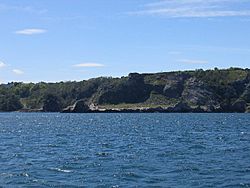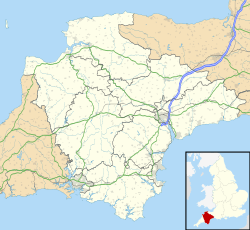Long Quarry Point facts for kids
Quick facts for kids Long Quarry Point |
|
|---|---|

Long Quarry Point from the sea
|
|
| Location | Torquay |
| Coordinates | 50°28′33″N 3°29′52″W / 50.475935°N 3.497739°W |
| Geology | Limestone |
Long Quarry Point is a cool spot on the coast near Torquay, Devon, England. It's a piece of land that sticks out into the sea, right below a place called Wall's Hill. This area is so special that it's part of a protected zone called the Hope's Nose to Wall's Hill Site of Special Scientific Interest.
Contents
What is Long Quarry Point?
Long Quarry Point is an old, unused quarry. A quarry is a place where rocks are dug out of the ground. Here, you'll find tall limestone cliffs at the back. There are also many large rocks and broken pieces of stone. The bottom of the quarry is now covered with grass and wild plants.
Along the edges, you can see several rock pillars. There are also old metal posts fixed into the rock. These were used to tie up boats. The very tip of Long Quarry Point is actually one of these rock pillars. You can get to the quarry by walking or by boat. A winding path leads down from Wall's Hill. It goes through a small wooded area and follows the cliff edge to the bottom.
The Rocks and Geology
This area is very important for understanding geology. It shows a special type of rock called Devonian Walls Hill Limestone. Scientists study it to see how ancient Stromatoporoid reefs grew. Stromatoporoids were sponge-like creatures that lived in the sea long ago. They built large reef structures, much like corals do today.
A Look at the History
Long Quarry Point is home to a big, old limestone quarry. It was called Long Quarry. People worked here a lot during the 1800s. They dug out stone for many buildings in the local area. Some of the stone was so good that it could be polished into a type of marble.
Climbing Adventures
The quarry walls and cliffs are a popular place for climbing. There are many routes for different types of climbing.
Deep-Water Soloing
One type is called deep-water soloing. This is where climbers go up cliffs without ropes. If they fall, they land safely in the deep water below. An example here is The Long Traverse, which is a grade 4c climb.
Sport and Traditional Climbing
You can also find many sport climbing routes on the quarry walls. Sport climbing uses fixed ropes and bolts for safety. There are also traditional climbing routes. These are found on places like the Grey Tower at the back of the quarry. Traditional climbing means climbers place their own protective gear as they go.


